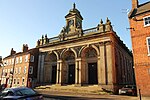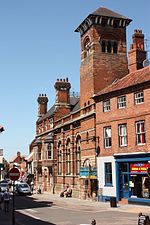Kelham Road
1849 establishments in EnglandCricket grounds in NottinghamshireEnglish cricket ground stubsNewark-on-TrentSports venues completed in 1849 ... and 1 more
Use British English from February 2023
Kelham Road is a cricket ground in Newark-on-Trent, Nottinghamshire. The first recorded match on the ground was in 1849, when the Newark played an All-England Eleven. In 1856, the ground hosted a its only first-class match when Nottinghamshire played an All-England Eleven. The ground is the home of Newark Ransome & Marles Cricket Club.
Excerpt from the Wikipedia article Kelham Road (License: CC BY-SA 3.0, Authors).Kelham Road
Newark Bypass, Newark and Sherwood Newark
Geographical coordinates (GPS) Address Nearby Places Show on map
Geographical coordinates (GPS)
| Latitude | Longitude |
|---|---|
| N 53.08018 ° | E -0.8225 ° |
Address
Newark Bypass
Newark Bypass
NG24 1FH Newark and Sherwood, Newark
England, United Kingdom
Open on Google Maps









